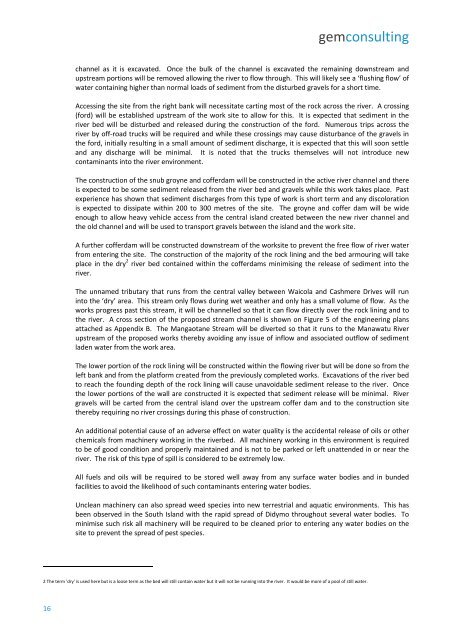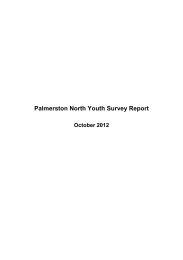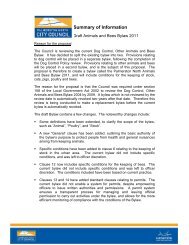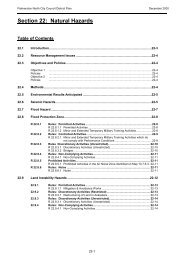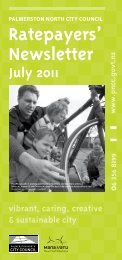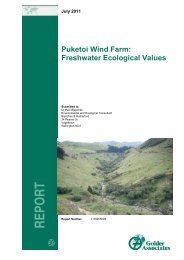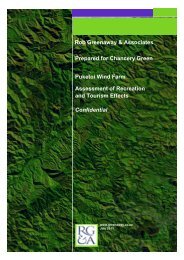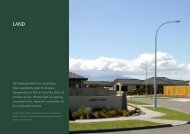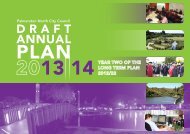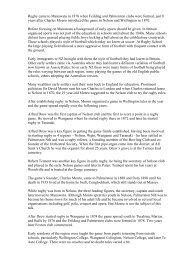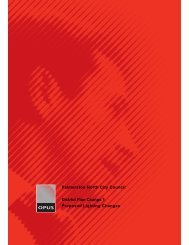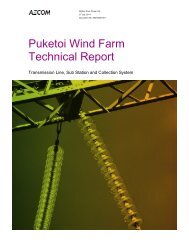Part 1 - Palmerston North City Council
Part 1 - Palmerston North City Council
Part 1 - Palmerston North City Council
You also want an ePaper? Increase the reach of your titles
YUMPU automatically turns print PDFs into web optimized ePapers that Google loves.
gemconsulting<br />
channel as it is excavated. Once the bulk of the channel is excavated the remaining downstream and<br />
upstream portions will be removed allowing the river to flow through. This will likely see a ‘flushing flow’ of<br />
water containing higher than normal loads of sediment from the disturbed gravels for a short time.<br />
Accessing the site from the right bank will necessitate carting most of the rock across the river. A crossing<br />
(ford) will be established upstream of the work site to allow for this. It is expected that sediment in the<br />
river bed will be disturbed and released during the construction of the ford. Numerous trips across the<br />
river by off‐road trucks will be required and while these crossings may cause disturbance of the gravels in<br />
the ford, initially resulting in a small amount of sediment discharge, it is expected that this will soon settle<br />
and any discharge will be minimal. It is noted that the trucks themselves will not introduce new<br />
contaminants into the river environment.<br />
The construction of the snub groyne and cofferdam will be constructed in the active river channel and there<br />
is expected to be some sediment released from the river bed and gravels while this work takes place. Past<br />
experience has shown that sediment discharges from this type of work is short term and any discoloration<br />
is expected to dissipate within 200 to 300 metres of the site. The groyne and coffer dam will be wide<br />
enough to allow heavy vehicle access from the central island created between the new river channel and<br />
the old channel and will be used to transport gravels between the island and the work site.<br />
A further cofferdam will be constructed downstream of the worksite to prevent the free flow of river water<br />
from entering the site. The construction of the majority of the rock lining and the bed armouring will take<br />
place in the dry 2 river bed contained within the cofferdams minimising the release of sediment into the<br />
river.<br />
The unnamed tributary that runs from the central valley between Waicola and Cashmere Drives will run<br />
into the ‘dry’ area. This stream only flows during wet weather and only has a small volume of flow. As the<br />
works progress past this stream, it will be channelled so that it can flow directly over the rock lining and to<br />
the river. A cross section of the proposed stream channel is shown on Figure 5 of the engineering plans<br />
attached as Appendix B. The Mangaotane Stream will be diverted so that it runs to the Manawatu River<br />
upstream of the proposed works thereby avoiding any issue of inflow and associated outflow of sediment<br />
laden water from the work area.<br />
The lower portion of the rock lining will be constructed within the flowing river but will be done so from the<br />
left bank and from the platform created from the previously completed works. Excavations of the river bed<br />
to reach the founding depth of the rock lining will cause unavoidable sediment release to the river. Once<br />
the lower portions of the wall are constructed it is expected that sediment release will be minimal. River<br />
gravels will be carted from the central island over the upstream coffer dam and to the construction site<br />
thereby requiring no river crossings during this phase of construction.<br />
An additional potential cause of an adverse effect on water quality is the accidental release of oils or other<br />
chemicals from machinery working in the riverbed. All machinery working in this environment is required<br />
to be of good condition and properly maintained and is not to be parked or left unattended in or near the<br />
river. The risk of this type of spill is considered to be extremely low.<br />
All fuels and oils will be required to be stored well away from any surface water bodies and in bunded<br />
facilities to avoid the likelihood of such contaminants entering water bodies.<br />
Unclean machinery can also spread weed species into new terrestrial and aquatic environments. This has<br />
been observed in the South Island with the rapid spread of Didymo throughout several water bodies. To<br />
minimise such risk all machinery will be required to be cleaned prior to entering any water bodies on the<br />
site to prevent the spread of pest species.<br />
2 The term 'dry' is used here but is a loose term as the bed will still contain water but it will not be running into the river. It would be more of a pool of still water.<br />
16


